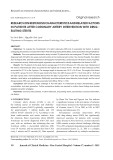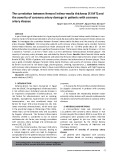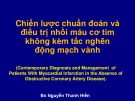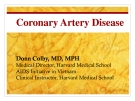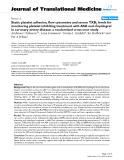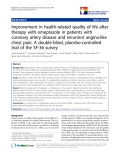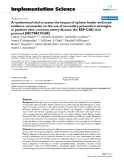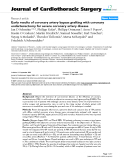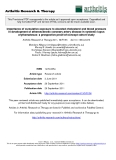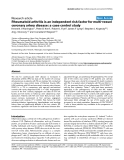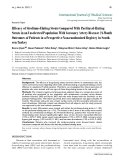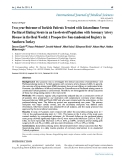Coronary Artery Disease
Donn Colby, MD, MPH Medical Director, Harvard Medical School AIDS Initiative in Vietnam Clinical Instructor, Harvard Medical School
At the end of the lecture, participants will know:
1. The epidemiology of Coronary Artery Disease
2. The risk factors associated with Coronary Artery Disease
3. How to use online tools to estimate a patient's risk for
myocardial infarction.
4. How to screen for and counsel a patient to reduce their risk
for coronary artery disease.
Learning Objectives
Definitions
Epidemiology
Risk factors
Estimating Risk for Coronary Heart Disease
Risk reduction
Outline of Presentation
Definitions
Coronary artery disease (CAD) is the pathologic process
affecting the coronary arteries (atherosclerosis).
Coronary heart disease (CHD) results from coronary artery
disease and includes angina pectoris, myocardial infarction, silent myocardial ischemia.
Cardiovascular disease (CVD) is the pathologic process (atherosclerosis) affecting the entire arterial system, not just the coronary arteries: Stroke, transient ischemic attacks, angina, myocardial infarction, and peripheral artery disease.
Leading causes of death, world, 2004
% of total deaths
Mathers, British Medical Bulletin, 2009
Worldwide causes of death, 2004
Mathers, British Medical Bulletin, 2009
Epidemiology (2)
Mathers, British Medical Bulletin, 2009
Epidemiology (3)
Deaths from Cardiovascular Diseases, USA 1990 - 1997
Cooper, Circulation, 2000
Epidemiology (4)
Cardiovascular Disease Risk in Urban and Rural China
Yusuf, Circulation, 2001
Epidemiology (5)
Risk factors
Modifiable Risk Factors
Tobacco Cholesterol ( LDL, HDL) Hypertension Diabetes Obesity Inactivity Family History of premature heart disease Male Increased Age
Association between total cholesterol and CHD risk
Stamler, JAMA, 1986
Risk Factor: Cholesterol
Association between blood pressure and CHD mortality
Prospective Studies Collaboration, Lancet, 2002
Risk Factor: hypertension
Association between diabetes and CHD mortality
Haffner, NEJM, 1998
Risk Factor: diabetes
Maximum exercise capacity and risk for CHD
Myers, NEJM, 2002
Risk Factors
Risk Factors: Increasing in China
CHD Mortality, Beijing, 1984-1999
Critchley, Circulation, 2004
Primary care doctors can screen for and treat the
modifiable risk factors for CAD. Screening for risk factors can be done at routine primary
care visits or yearly physical exams
Screening is an important part of preventive medicine. If positive for a risk factor, counseling and treatment can
decrease the future risk for cardiovascular diseases.
Screening
Modifiable risk factors
Inactivity Obesity Tobacco Cholesterol ( LDL, HDL) Hypertension Diabetes
Screening
Screening
Low Risk
High Risk
Regular Screening and counseling
Obesity, Physical Activity
Smoking
Regular Screening and counseling
Blood Pressure
Regular screening for age > 18 (at least every 2 years)
Fasting Lipids
Age > 35 every 1-5 years
Age > 20 every 1-2 years
Every 1 year
Fasting Blood Sugar Every 1-3 years Sources: American Association of Family Physicians (AAFP), United States Preventive Services Task Force (USPSTF), Canadian Task Force for Preventive Health Services (CTFPHS)
Screening Guidelines
Online risk calculator:
http://hp2010.nhlbihin.net/atpiii/calculator.asp
Based on the Framingham Heart Study
Longitudinal observational cohort study of risk factors
for cardiovascular disease
Over 16,000 people followed in several cohorts since
1948
Generated from an American population: results may
not be accurate for other ethnic groups.
Risk Estimation
CAD risk calculator: Smartphones
Screening for asymptomatic CAD
Low Risk Adults
Most organizations recommend NO screening Consider for some jobs for public safety (pilots, police, etc…)
High-Risk Adults
No recommendation for or against screening (American
College of Cardiology, American Heart Assoc., USPSTF) The most common screening test is the Exercise Tolerance
Test (ETT, Exercise ECG) Confirm positive ETT with exercise radionuclide myocardial perfusion
imaging or exercise echocardiography
If the confirmatory test is positive refer for cardiac arteriography and
revascularization
Lifestyle Changes:
Regular exercise will decrease risk of CAD
Weight loss for obesity
Ideal BMI < 25 kg/m2
Smoking cessation
Risk Reduction (1)
Risk Reduction (2)
Treat risk conditions:
Hypertension: goal of BP < 140/90
Hyperlipidemia treatment goals*:
LDL < 160 (10-year risk low: <10%) LDL < 130 (10-year risk moderate: 10-20%) LDL < 70-100 (CHD or high risk > 20%)
Diabetes: treat following standard guidelines
*ATP-III Guidelines (http://www.nhlbi.nih.gov/guidelines/cholesterol/dskref.htm)
Risk Reduction (3): Aspirin
The USPSTF recommends Aspirin to reduce the risk of coronary artery disease and myocardial infarction if the benefit exceeds the risk for GI ulcer or bleeding:
The table above applies to adults who are not taking NSAIDs and who do not have upper GI pain or a history of GI ulcers.
Coronary Artery Disease is the leading cause of
death in Vietnam and in the world
Many of the risk factors for CAD are treatable.
Primary Care Physicians can decrease the risk of
CAD in their patients by screening for and treating associated conditions: Obesity, inactivity, hypertension, hyperlipidemia,
diabetes.
Summary
Thanks!
EXTRA SLIDES

